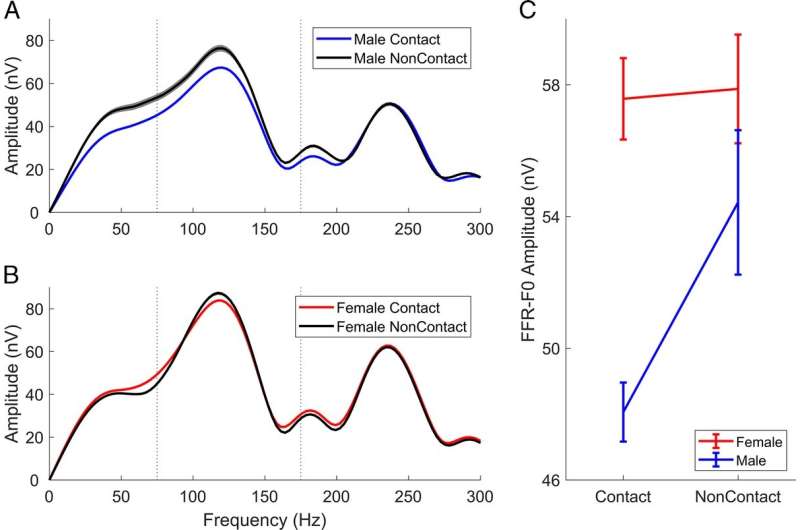This article has been reviewed according to Science X's editorial process and policies. Editors have highlighted the following attributes while ensuring the content's credibility:
fact-checked
trusted source
proofread
Auditory processing: The 'canary in the coal mine' for subconcussive head injury

It is widely accepted that an undiagnosed concussion is dangerous to the health and safety of an athlete. To prevent long-term concussive damage, sports organizations have focused on identifying concussion symptoms, providing the athlete with care as soon as the injury is suspected.
Yet, accumulating evidence shows that the smaller hits also adversely affect the brain over time.
Player-to-player or player-to-ground contacts in football, elbows to the head in basketball, or heading the ball in soccer cause subconcussions, injuries to the brain that are insufficient to cause the acute symptoms of a diagnosable concussion.
Some athletes' brains do not change from these repeated hits, but for others, subconcussions have been shown to cause chronic traumatic encephalopathy (CTE), a progressive degeneration of the brain that leads to mood instability and problems with memory, focus and thinking.
A study resulting from a joint collaboration between Northwestern's Auditory Neuroscience Laboratory and Northwestern University Athletics and Recreation and published in the journal Exercise, Sport, and Movement has uncovered a brain measure that could one day help to identify an athlete's tipping point.
"There has been no way to know if or when an athlete will reach their tipping point—that subconcussive hit when CTE becomes an inevitable consequence of repeated subconcussions," said Nina Kraus, Hugh Knowles Professor of Neurobiology and Otolaryngology in the School of Communication at Northwestern, who served as senior author on the study.
"By discovering the proverbial 'canary in the coalmine,' we can increase player safety without compromising the sports we love," Kraus said. "Identifying what is 'too much' for an individual player could preclude the need for sweeping changes to be made to the game."
The biological measure, called the frequency-following response (FFR), is obtained by placing a few sensors on the athlete's head and playing sounds to their ear. The FFR is both objective and easy to obtain.
Unlike current concussion tests, which assess balance, vision and cognition, the FFR examines auditory processing. The authors found that the brain's response to a sound's pitch—that part of sound that distinguishes notes on a piano or different voices—is poorer in contact athletes compared to non-contact athletes. Auditory processing may be more sensitive than the other domains currently involved in concussion assessment.
This finding was specific to male contact athletes, for whom more years spent playing a contact sport led to poorer pitch processing, according to the study.
Pitch is processed in multiple regions of the brain, and what the sensors pick up reflects coordinated neural activity within and across these multiple regions. The poorer pitch processing in the contact athletes indicates reduced synchrony in the firing patterns of these neurons as a result of continued subconcussions.
"Why exactly women's brains don't seem to show as much of an impact on pitch processing from playing contact sports needs further study," Kraus said. "It may be that estrogen mediates the relationship between subconcussions and brain dysfunction."
Kraus is an expert on auditory processing, whose holistic view of hearing and how it can inform us about brain health is explored in her book "Of Sound Mind."
"Overall, the study suggests that sound processing could be a useful way for scientists and sports medicine practitioners to assess and understand how collisions impact brain health," she said.
Being physically active continues to be one of the best things we can do for our overall health, Kraus said, including our brain health. However, this research could ultimately help people make more informed decisions about which sports they want to play and what the consequences of different activities over different time periods can be.
The study involved more than 700 male and female athletes who played 19 contact and noncontact sports, from swimming, cross country and golf (noncontact) to football, lacrosse and field hockey (contact).
More information: Nina Kraus et al, Subconcussion revealed by sound processing in the brain, Exercise, Sport and Movement (2023). DOI: 10.1249/ESM.0000000000000011



















